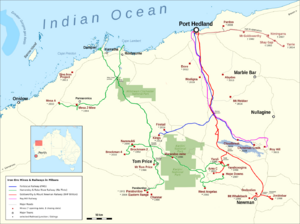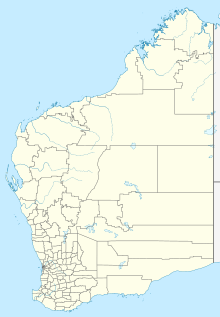Cloudbreak mine facts for kids

Cloudbreak Mine in distance - 2008
|
|
| Location | |
|---|---|
| Location | Shire of Ashburton, Pilbara |
| State | Western Australia |
| Country | Australia |
| Coordinates | 22°19′26″S 119°23′49″E / 22.323978°S 119.396942°E |
| Production | |
| Products | Iron ore |
| Production | 40 million tonnes/annum |
| History | |
| Opened | 2008 |
| Owner | |
| Company | Fortescue Metals Group |
| Website | Fortescue website |
The Cloudbreak mine is a large iron ore mine in Western Australia. It is located in the Pilbara region, about 89 kilometres west-south-west of a town called Nullagine. The mine is part of the Chichester Range.
The Fortescue Metals Group (FMG) owns and runs the Cloudbreak mine. It is one of four iron ore mines that FMG operates in the Pilbara. The other mines are Christmas Creek mine, Kings Valley mine, and Firetail mine.
FMG is the third-largest iron ore mining company in the Pilbara. The two bigger companies are Rio Tinto and BHP. The Cloudbreak mine is on land called Mulga Downs Station, which is owned by Gina Rinehart.
Contents
How the Mine Started

Fortescue Metals Group (FMG) bought the land for the Cloudbreak and Christmas Creek mines in 2003. In February 2006, the company started building port facilities at Port Hedland. This is where the iron ore would be shipped from.
In August 2006, FMG raised $3.2 billion to help pay for its projects. Construction on the Cloudbreak mine itself began in October 2006.
Mining and Transport
Fortescue started digging for iron ore at Cloudbreak in October 2007. The mine began producing iron ore in 2008. In its first full year, the mine produced 28 million tonnes of iron ore.
The iron ore from the mine is processed right there at the site. This means it is cleaned and prepared. Then, it is loaded onto trains. The trains carry the ore to the coast at Port Hedland using the Fortescue railway. Once at the port, the ore is loaded onto big ships.
Building the 280-kilometre long railway line from Cloudbreak to the Herb Elliott Port in Port Hedland started in November 2006. The railway was planned to be ready within 18 months. A big storm (cyclone) in March 2007 caused delays and was a very sad event for the project. The first train from the mine to the port ran on April 5, 2008.
Mine Workers and Safety
The workers at the Cloudbreak mine use a "fly-in fly-out" system. This means they fly to the mine for their work shifts and then fly back home afterwards. Workers arrive and leave from Fortescue Dave Forrest Airport, which is about five kilometres from the mine.
In January 2013, the Cloudbreak and Christmas Creek mines together were producing about 90 million tonnes of iron ore each year. Fortescue also developed its Christmas Creek mine for US$360 million. They built a mine and processing plant there and connected it to their existing railway. Christmas Creek was expected to produce 16 million tonnes of iron ore in its first year. Fortescue aimed to produce 95 million tonnes of iron ore per year by 2012.
Mining at Cloudbreak was stopped for a short time on December 24, 2010. This happened after a serious incident, as a sign of respect and to make sure all workers were safe.
In October 2013, about 1,500 workers at the mine had to leave quickly. A large bushfire (wildfire) was getting close to the village where they lived. The workers were taken to the Christmas Creek mine until the danger passed. Luckily, no one was hurt, and the mine itself was not damaged by the fire.
Protecting the Environment
The Cloudbreak mine project cost about A$2 billion. When it was approved by the Minister for the Environment, some people were worried. This was because there were several endangered species living in the area where the mine would be built. One of these was the incredibly rare night parrot.
To get permission from the environmental protection agency (EPA), the mine had to create a special plan. This plan was to make sure that mining activities would not harm these rare animals or their homes.
In 2005, during a survey for FMG, two biologists saw a small group of night parrots. This happened at Minga Well on April 12, 2005. Before this, there had been unconfirmed sightings of the bird nearby in 2004.


